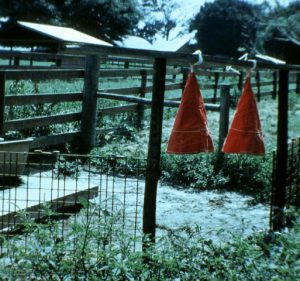Controlling flies on livestock in Florida is a challenge. Please note the word, “control.” We would love to substitute that word with “eradicate”, but that is not realistic. Our main pests are horn flies and face flies. In Florida, it seems as if we never really get a break from the pests. There are a few options that can give some relief to your cattle.
It may seem somewhat obvious the reasons to control flies. However, if you consider the reasons, it might prompt you to make an extra effort. First, it is estimated that horn flies take 20-30 small blood meals each day. The pain and irritation the biting causes prevents adequate food consumption and rest. This chain of events results in poorer milk production and lower weaning weights. Second, biting flies are carriers for diseases such as anaplasmosis. Third, horn flies can cause severe damage to teats on heifers. So, how many can we tolerate if we cannot eradicate? The economic threshold on beef cattle is 200 flies per cow; above that you are losing money.
What Products are Available?
Most sprays will only provide a moment of relief, so it is desirable to find something more long-lasting. Feed-through products use an insect growth regulator or a larvicide to disrupt the life cycle of the fly in the cow manure. The down-side is that your neighbor must use the product as well because flies can travel. Fly tags are another option. The caveat is that the tags should be rotated based on product formulation and should be removed after 3-5 months. Letting the last little bit “trickle” out of the ear tag can set up some insect resistance creating “super flies” that do not respond to any product. Dust bags are highly effective. However, you must put them where cattle are forced to use them and it is not practical for large cattle operations.

What About No Treatment at All?
Perhaps solve the problem-not treat the symptoms. It is estimated that the heritability of fly resistance in cattle is very high at .58. The simplistic view is to cull cows that have lots of flies and keep younger cows to slowly turn the heard toward resistance. The effectiveness of Brahman breeding in causing lower numbers of insecticide-resistant horn flies has been documented. Mean horn fly numbers decreased significantly as the percentage Brahman breeding increased with 50% Brahman breeding reducing horn fly numbers by 140 flies per cow (Steelman, et. Al, 2003). Brahman cattle have 3 times the number of hairs per unit of surface area than do most British and Continental breeds. Each hair follicle has two sebaceous glands that secrete a substance that reflects sunlight and provides a natural resistance to insects. Cattle with a very slick and shiny summer hair coat usually have less fly problems; this could be a way to select for fly resistance as well. If milk production and weaning weights are reduced by horn fly presence, maybe breeding can prevent the losses.
Within-breed variation occurs as well. Interestingly, as frame size increases, cattle still maintain the same number of hairs in their coat. When you enlarge frame size, you have more space between hairs and less production by the sebaceous glands as they are also reduced per square inch. Additionally, each animal produces a natural chemical called thrombin which counteracts the fly’s anti-coagulate factor. Flies have more difficulty feeding on animals with higher levels of this compound and won’t choose the animal for their host. One last note: bulls usually have two to four times as many flies as cows because flies are attracted to testosterone. Bulls have a hard life in more ways than one.
For more information:
Fly Control-University of Florida
Progressive Cattleman Article on Genetic Fly Control
Alternatives for Fly Control-Journal of Economic Entomology
 0
0
